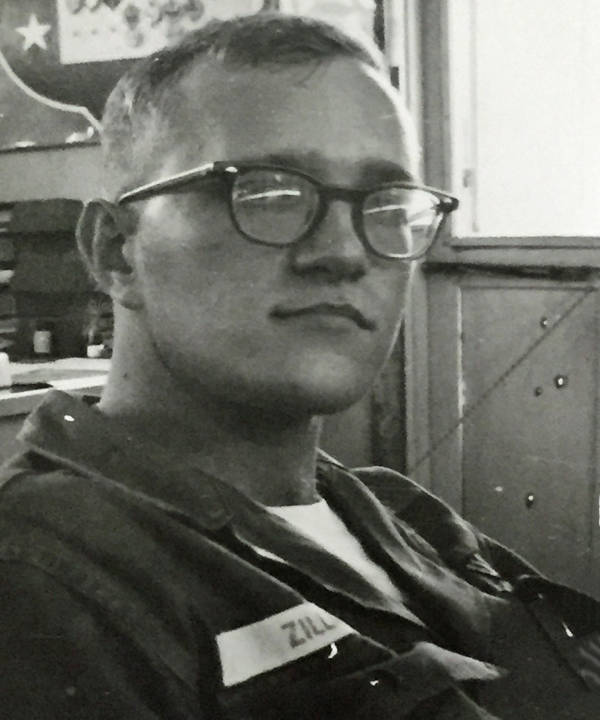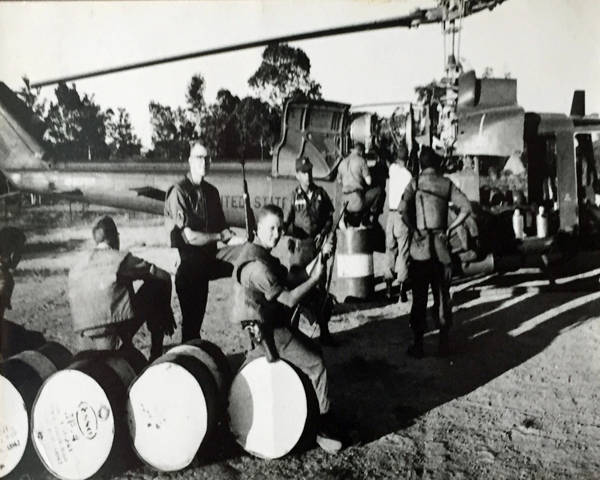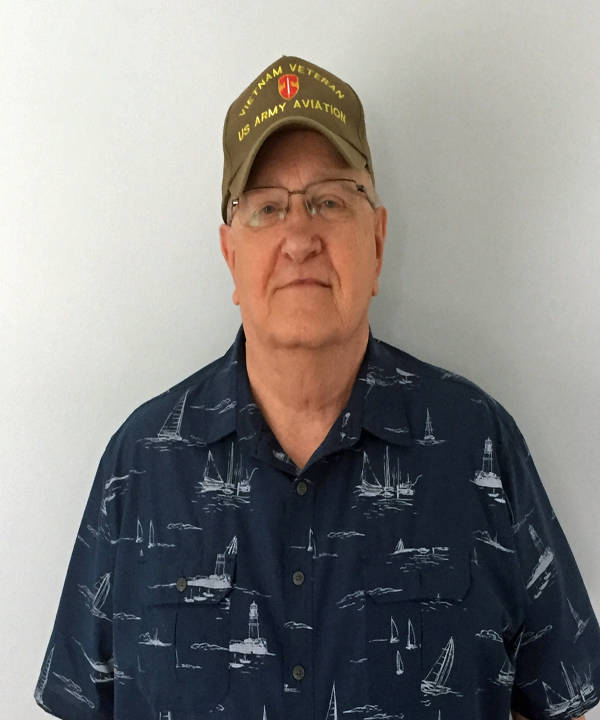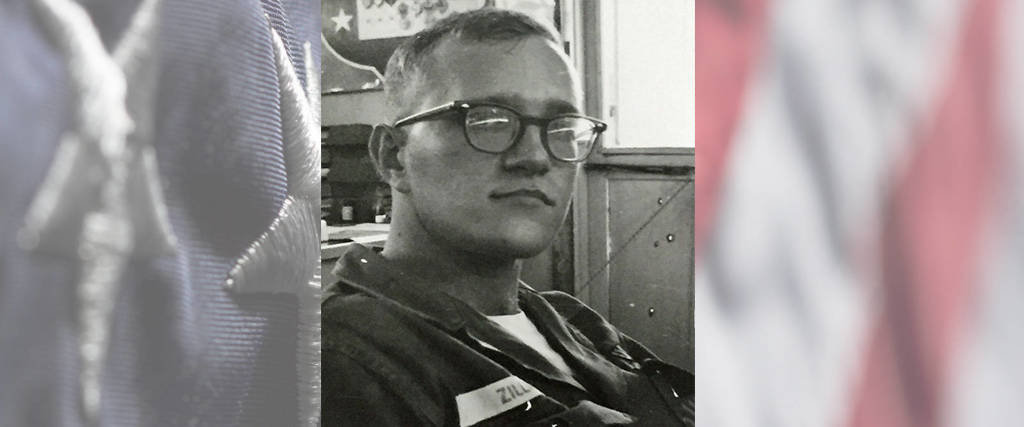U.S. Army Vietnam War Lombard, IL Flight date: September, 2019
By Mark Splitstone, Honor Flight Chicago Veteran Interviews Volunteer

On Tom Zilla’s third day in Vietnam in September of 1964, he was at Pleiku Air Base waiting to be flown to his ultimate destination of Da Nang. He was told that there would be a C-130 transport plane arriving soon to pick him up. However, they also told him that because the base was subject to frequent enemy mortaring, the plane would not come to a complete stop after landing. Instead, the plane would taxi slowly, turn around, then lower its ramp while continuing to taxi. Tom would have to run to catch up to it, then run up the ramp to get on board. Sure enough, as the plane was taxiing and Tom was running to catch it, mortar shells started exploding. Tom says he was in good shape and did a lot of running, but that he never ran so fast in his life. He didn’t stop running until he made it up the ramp, through the length of the plane, and all the way to the cockpit. Needless to say, it was an exciting introduction to Vietnam.
Tom was born in Chicago in 1940 and grew up in the Wicker Park neighborhood. He graduated from high school in 1958 and went to Wright Junior College for a year before going to work at the JC Whitney/Warshawsky company, which was a supplier of automotive parts. While working there, he also took a course in graphic design at the Art Institute, which would help him in his work on the JC Whitney catalog. During this period, he was a scoutmaster and a merit badge counselor for the first aid merit badge which included training with the Red Cross. This would come into play during his time in Vietnam. He says he enjoyed this part of his life because he was making money and having fun. But in 1963, he was drafted and inducted into the Army on Halloween.
Tom went to Basic Training at Fort Knox. A few weeks after he got there, John F. Kennedy was assassinated. Nobody knew what was going to happen next and because of the concern, all military personnel were placed on high alert. They gave all the new recruits weapons; Tom says it was pretty scary. Most of them were young and untrained and he wasn’t sure that it was such a good idea to arm them. Tom, 23 at the time, was older than most of the other recruits. He recalls that Basic Training was temporarily suspended, and that they watched the JFK funeral on television.
In the initial military testing, Tom scored very high in mechanical aptitude, mostly because of his experience with the JC Whitney catalog. He was therefore sent to Fort Rucker in Alabama to become a helicopter mechanic. The problem was that while he could identify all the parts, he didn’t really know how they fit together. Fortunately, he was able to switch his specialty to flight operations coordinator, which included tower operations, airspace control, crash and rescue locating, and weather forecasting. Following training, he was deployed to Fort Riley, Kansas at Marshall Airfield. After several months there, two airlift platoons were created, each of which included twelve Huey helicopters. They were deployed to Vietnam.

After his initial “excitement” on the runway at the Pleiku Air Base, Tom spent the rest of the war stationed in Da Nang. Flight operations included managing tower operations and flight plans – Tom describes it as controlling highways in the sky. The missions for his platoon included troop insertions and extractions, medical evacuations, supply runs, and air assault in support of Marines, U.S. Army Special Forces, and the South Vietnamese army. Some of the missions were very short but others would last overnight. While officers flew the helicopters, the enlisted men rotated in the role of door gunners. Tom remembers that the first time they were shot at while he was a door gunner, his first thought was, “Oh my God, they’re shooting at us!” He recalls his CO telling him that he had better return fire or else they weren’t going to be up there very long.
Because this was so early in the war, Tom and his fellow soldiers were technically in Vietnam in the role of advisers. They had to wear civilian clothes whenever they left the base, and they weren’t allowed to fly the American flag anywhere. Because the American forces in Vietnam were still relatively small and a lot of the facilities had not yet been built, Tom and his fellow soldiers lived in a hotel with air conditioning and private bathrooms. They would work from dawn to dusk at the air base and then return to the hotel at night. While Da Nang was the second largest city in Vietnam, it was still very undeveloped and poor. The huge American buildup hadn’t happened yet, so Da Nang in many ways seemed like a small French colonial town. The air base, though, was big and getting bigger. While Tom was there, U.S. Marines were dispatched to guard the air base and were considered the first U.S. combat troops to go to Vietnam. Clearly, Americans were fighting and dying before the Marines got there. In fact, hundreds of Americans had already died before the first “combat troops” had arrived.
Even though they were technically “advisers” and “not in combat,” Tom recalls that an officer in his unit was killed just shortly after Tom got there. He was shot while on a mission and bled to death before they could make it back to Da Nang. Another time, when a fellow soldier was shot causing a sucking chest wound, they were at a special forces camp rather than at Da Nang. The usual medical personnel weren’t present and since Tom knew quite a bit about first aid because of his training with the Boy Scouts and Red Cross, and he hurriedly took the cellophane from his cigarette pack to create a vacuum over the wound and then bandaged him up. For his heroism, Tom was awarded the Bronze Star. During his time in the Army, Tom also received an Army Commendation Medal for meritorious service as well as an Air Medal for the number of missions that he flew.
Tom completed his Vietnam service in September, 1965. Some of the members from his unit left the country on the same flight and there was huge cheering when the plane was off the ground. The flight back was a “giant party.” Because his service in Vietnam was early in the conflict, he watched the American involvement closely as it unfolded in the ensuing decade. He recalls living in Chicago in 1968 and seeing the riots at the Democratic National Convention and wondering if everybody had gone crazy. He says that when he was in Vietnam, the Americans got along well with the Vietnamese civilians and Vietnamese army, and that he couldn’t understand what happened after he had left.

After Vietnam, Tom went back to work at JC Whitney and there he met the young woman who would become his wife. They were married in 1974, have three children, six grandchildren and still live in the same house in Lombard where they moved to over 40 years ago. After leaving JC Whitney, he worked for McMaster-Carr for 17 years. He completed his career at W.W. Grainger working on their catalog and retiring in 2000. In retirement, Tom enjoys painting watercolors and spending time with his kids and grandkids.
Tom is also active in the Vietnam Helicopter Crew Members Association and is a past Commander of the VFW post in Lombard. Even though what he did was very dangerous, he realizes that, since he was living in a hotel, many soldiers had it far worse than him. He also appreciates that his role allowed him to have closure when fellow servicemen were killed or wounded. This certainly wasn’t the case for others who served in Vietnam. Tom feels very good about his service, but feels regret that Vietnam Veterans were never really welcomed home. “This is why when a Vietnam vet meets another vet, they say welcome home to each other.”



